|
The
House of Correction
at
Folkingham
Folkingham, eight miles north of Bourne on the A15, is now merely a large village but it was once an important place in Lincolnshire because it was the seat of the Quarter Sessions, the higher court that dispensed justice for the area each fortnight from the Assembly Rooms at the Greyhound Hotel, which is why the austere House of Correction, or prison, was built there. The building that survives dates back to the early 19th century and replaced an earlier one with a prisoners' exercise yard at the rear that was in use from 1609 until 1808. It has since been converted into two private stone-roofed houses, Numbers 32 and 34, facing the spacious village market place on the east side.
It was here that lawbreakers were imprisoned and beneath the keeper's house were four tiny cells for men together with a "dark room" for those sentenced to solitary confinement, with only four small air holes in the door. There were also two cells nearby to accommodate women prisoners.
The village constable was responsible for keeping the prisoners occupied, one task being the cutting of cattle and horse troughs from solid blocks of stone quarried locally using a mallet and chisel. A bulletin of 1802 records that the keeper was then John Speight who was receiving a salary of £50 a year. This was a period when being poor was also a crime and those without means in Folkingham village for three years were granted a begging badge.
Conditions were deplorable and reform was inevitable. The English philanthropist, John Howard, born at Hackney in London in 1726, had spent some time in jail at Brest in France as a prisoner of war in 1756 where he suffered and witnessed terrible hardships. Later, as High Sheriff of Bedfordshire, he was appalled by the conditions in Bedford Gaol and vowed to devote himself to prison reform. He subsequently toured British prisons including visiting the town jails at Boston and Stamford and the House of Correction at Folkingham where he witnessed the distressing sight of a woman prisoner nursing a child at her breast. She was serving a one-year sentence but the child died while its mother was still in custody. Food allowances were also a regular practice at Folkingham, amounting to 6d. worth of bread each week and Howard commented that the keeper "starves his prisoners" but his report does not mention the jail fever and smallpox that were rife in other such institutions.
Howard's investigations led to two Acts of Parliament in 1774 enforcing better conditions for prisoners and greater standards of cleanliness and the Howard League for Penal Reform that was founded in 1866 was named after him.
The premises at Folkingham soon became totally inadequate for their purpose and in 1808, a new building was proposed on the Billingborough Road to plans drawn up by the architect Bryan Browning who was later to design Bourne Town Hall. The chosen site had previously been occupied by Henry de Beaumont's castle, with an inner and outer moat, and most probably destroyed by Parliamentary forces during the Civil War of 1642-49. It was known as County Bridewell, or the second House of Correction, built for the County of Kesteven, and which was in use from 1809 until 1878. The only part that remains is the gatehouse and governor's house, now preserved at the end of an impressive driveway with wrought iron entrance gates, with the wording HOUSE OF CORRECTION A D 1825 engraved below the pediment, the date being that of the first phase of extensions rather than the original building date.
The gatehouse was intended to be a powerful apotropaeic, having the purpose of averting or turning away evil, and consists of a stone-faced building with three bays, arched windows half blanked off and half grilled, the sides and back being finished in brick. The centre is a deeply chamfered niche leading to a tunnel vaulted entrance at the end of which is a smaller doorway. The gateway is reminiscent of the style of Sir John Vanbrugh who had designed the final sections of the nearby Grimsthorpe Castle in 1715 and Browning may well have been influenced by his work.
Building started in 1808 and additions were made in 1825, 1849 and 1852 and it finally provided accommodation for 70 prisoners and prison officers. Inside there was a chapel and several punishment devices including a hand crank similar to a paddle wheel, a treadmill, a whipping post and stocks capable of holding three miscreants at a time. The entrance to the cells was through the dining room and the entire prison was surrounded by a high wall.
The prison finally closed in 1878 and the Grantham Journal
reported on Saturday 4th May:
By order of the Prison Commissioners, this gaol was
closed on April 30th. On Saturday last was seen a melancholy sight by those
who happened to be travelling on the Billingborough Road. Two gangs of
prisoners, handcuffed to two chains, were marched from Folkingham to
Billingborough, and thence conveyed by train to Southwell. One of the
prisoners having a term of years unexpired was conveyed to London, where he
will probably not find his confinement so agreeably relieved by songs from the
birds and sweet fragrance from the flowers and fields. Much regret has been
expressed at the decision of the Commissioners to close the prison, and it was
hoped the little expense at which the gaol was worked would have influenced
them; but, doubtless, the absence of a railway nearer than three miles has
weighed considerably against its retention.
In recent times, the building was bought by Arthur Peterson, a London civil servant, who
had planned to turn it into his retirement home. The Historic Buildings
Council awarded him a grant of £1,000 towards the cost of structural repairs
but he was unable to raise the large sum of money needed for complete
restoration before it could be considered habitable. The building was later
acquired by the Landmark Trust, an organisation that seeks out unusual and
empty properties throughout Britain and turns them into holiday accommodation
with all mod cons and that is what has happened with the House of Correction
that has become a favourite stopping place with visitors from America and
Japan while the stocks and whipping post have been preserved in the west end
of the nave of the village church.
|
LINKS WITH THE PAST
Henry Matsell of Bourne, a Lincolnshire policeman and Kesteven constable, was
the last to live at the House of Correction and the cells could be
reached by going through the constable's living room. The jail was closed in 1878 and
the remaining prisoners transferred elsewhere but the prison officers'
quarters continued to be used for several years afterwards as temporary
accommodation for homeless villagers. Constable Matsell was a relative of Mr
Michael Matsell, of Lincoln, who owned this photograph. |
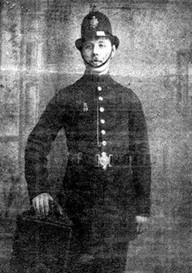 |
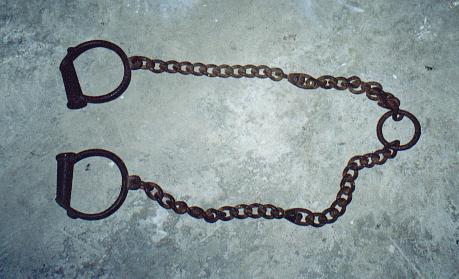 |
Punishment
instruments were prevalent at the House of Correction and included these
iron manacles which were frequently used for securing unruly and
troublesome prisoners. This set has survived and is now on display at
the Heritage Centre in South Street, Bourne. |
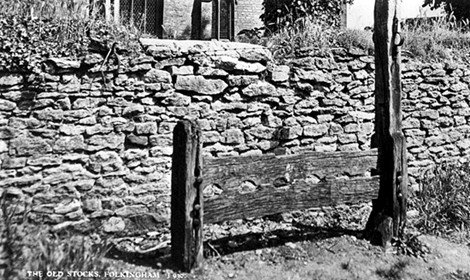 |
|
The village stocks at Folkingham
which probably came from the House of Correction when it closed in
1878. |
|
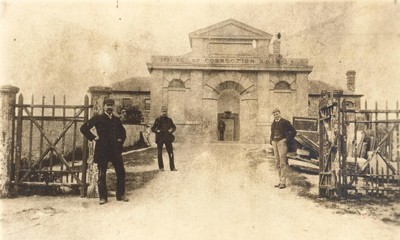 |
|
The House of Correction in the mid-19th century (above) and a view of the
building in 1909 taken from a postcard by
the Bourne photographer Ashby Swift (below).
|
|
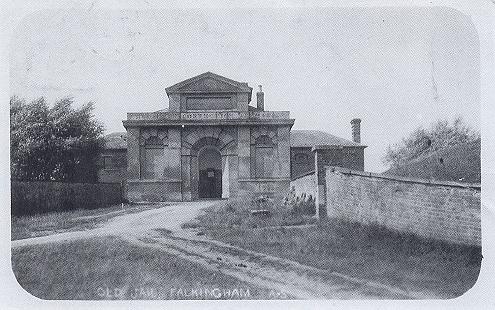 |
|
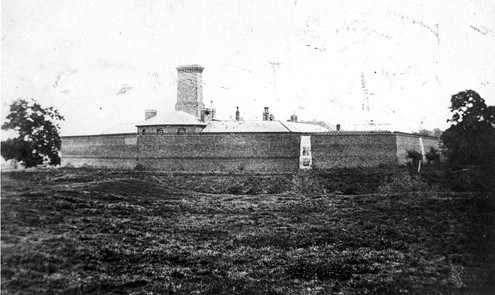 |
|
The House of Correction was surrounded by a high wall (above) but after it
closed, the buildings stood empty and disused for many years as these
views from circa 1920 indicate. |
|
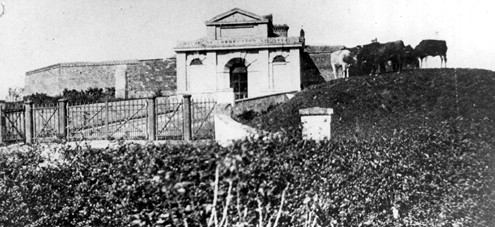 |
|
THE HOUSE OF CORRECTION
Folkingham is a location in South Lincolnshire that had a place of
importance greater than it has today. It boasted an important coaching
inn, the Greyhound, had a regular market and even qualified for its own
Quarter Sessions. The castle at Folkingham, Norman in origin, was
rebuilt in 1321 by Henry Baron de Beaumont, and was part of an important
chain of castles, Lincoln, Sleaford, Bourne and Castle Bytham,
dominating the roads eastwards to the fens and southwards from Lincoln
through the forests of Kesteven to the Vale, leading to London. It
became a ruin in 1507 and then in 1611 a minor prison for the idle and
disorderly was built on the site. From 1809 until 1878 it became a House
of Correction, being enlarged in 1825 when the present gateway with its
Governor's House were added. This gateway is the only part of the
buildings remaining.
NOTE: Contributed by Andrew Sumner to
the Lincolnshire Family History Society magazine, May 2001. |
|
FROM THE ARCHIVES |
|
Elizabeth Clark, servant in husbandry at Carlton
Scroop, was committed to the House of Correction at Folkingham for one
month by the Rev D Potts for ill behaviour and disobeying her master's
lawful orders. - news item from the Stamford Mercury, March 1813.
On Saturday last, Sarah Row, of Langtoft, single woman, was committed by
the Rev S E Hopkinson and Bernard Cracroft, clerks, to hard labour at
Folkingham Castle for one year, for having a bastard child chargeable to
the parish. - news item from the Stamford Mercury, March 1813.
On Saturday last, Jane Woodcock, of Bourne, single woman, was
committed to Folkingham Castle (by the Rev S E Hopkinson and William
Waters, Clerks, Magistrates for Kesteven), for one year, for having
brought a charge of three children upon the parish. - news report
from the Stamford Mercury, Friday 2nd June 1820.
FRAUDS UPON PARISHES: Rowland Wakefield, a labourer, of Haconby, near
Bourne, having refused to pay the parish officers £4 due upon an order
of bastardy, was on Saturday last committed to Folkingham gaol for
non-payment. The constable having imprudently placed him on a horse, on
arriving near Folkingham, the culprit rode off and afterwards made a
violent assault and effected an escape. He has, however, since been
apprehended and, on being searched, to the surprise of the constable,
£100 in new bank bills was found upon his person, which money is stated
to be his own property! He has been finally committed for the escape.
- news report from the Stamford Mercury, Friday 13th April 1821.
At the Town Hall at Bourne on Saturday last, Sara Lyon was committed
by the magistrates to hard labour for one month in Folkingham Castle for
deserting the service of her master, John Faulkner, of Witham-on-the-Hill,
to which she had been hired for a twelve month. - news report from
the Stamford Mercury, Friday 4th July 1823.
Thomas Watson, labourer, late of Bourne, pleaded guilty at the
Kesteven Sessions held at Bourne on 19th October to stealing a quantity
of horse-hair, the property of Joseph Shotbolt, and was sentenced to be
imprisoned with hard labour at Folkingham House of Correction for three
calendar months, the last week solitary, and to be privately whipped.
- news report from the Stamford Mercury, Friday 19th October 1830.
An inquest was held at Folkingham, near Bourne, on the 17th inst.,
and also by adjournment on the 18th, by Samuel Edwards, coroner, on the
body of John Bird, a youth 14 years of age, lying dead in the House of
Correction in that place. It being rumoured that the deceased had come
to his death by the improper treatment of the officers of the prison,
great interest was excited pending their investigation. Many of the
prisoners were examined, also three medical gentlemen. The deceased had
long previously to his imprisonment laboured under inflammation of the
lungs, which brought on fever, of which he died on the 13th inst. in a
natural way and by the visitation of God and a verdict to that effect
was recorded. The jury, however, deemed it their duty to state on the
face of the verdict that the conduct of Mr White, the governor, and of
Samuel Dawson, the assistant, towards the deceased was upon one occasion
(about four weeks since) unnecessarily severe, when the deceased, for
alleged neglect of work at the treadmill, was forcibly pulled from the
rails of the mill and fell with great force on a stone floor: that in
the governor's absence, the assistant gaoler violently beat the
deceased: that deceased was then hand-cuffed, leg-ironed, and dragged by
the legs on a wet pavement to a solitary cell, where he remained for
many hours, during the first seven of them being still hand-cuffed and
leg-ironed. For this the governor and his assistant were
reprimanded by the coroner; but it is only justice to the officers of
the prison to observe that it was proved by all the prisoners examined,
and by other witnesses, that the general conduct of the parties to the
prisoners was kind and humane. The deceased had been sentenced to hard
labour at Bourne for stealing cheese and the period of his sentence was
to have expired on the very day he died. - news report from the
Stamford Mercury, Friday 24th February 1832.
Previously to the sessions just held in Kesteven (at Bourne Town Hall
on 6th April) there were 16 prisoners at Folkingham House of Correction
undergoing various terms of imprisonment, of whom 9 were from the north
division and 7 from the south; of these 7 can neither read nor write, 2
can read imperfectly and 7 can read and write imperfectly. Thus it will
be seen that not one of the above can even read well. - news report
from the Stamford Mercury, Friday 9th April 1847. |
|
ESCAPEES FROM
FOLKINGHAM GAOL
OR HOUSE OF CORRECTION
Many prisoners escaped from the gaol including these which were reported by the Stamford
Mercury on the dates stated:
¬ Whereas on Monday night, the 24th of November
last, John Thomson, a youth about eighteen years of age, black hair,
pockmarked, in a red waistcoat and leather breeches, broke out of the gaol at
Folkingham by sawing an iron bar in two and getting over the iron spikes with
his irons on, and made his escape. Whoever can take him and bring him to the
gaoler at Folkingham shall have ten shillings reward and reasonable charges,
paid by the Keeper of Folkingham Gaol aforesaid.
Note: The said John Thomson has, since he made his escape, broken open a house
at Bourne and stole from thence, a leather apron, a pair of new shoes, two
pair of soles, a pair of pinchers, 4 or 5 awls, wax and thread, has changed
his habit, having now on a brown coat, was seen to go through Stamford on
Saturday last, and asked for old shoes to mend. - Thursday 4th December 1735.
¬ Whereas on the 23rd of this instant in the
night, Samuel Pickworth broke out of the gaol at Folkingham. He is a fresh
coloured man, about 23 years of age, middle-sized, brown coloured hair, in a
drab coloured coat with mohair buttons, and leather breeches, was born at
Bourne in Lincolnshire, and by trade a codder [fisherman]. Whoever brings the said Samuel
Pickworth to the aforesaid gaol in Folkingham shall receive a guinea reward of
the Keeper of the said gaol.
- Thursday 27th January 1737.
¬ Broke out of Folkingham Gaol, Samuel
Richardson of Bourne, razor grinder, a little-sized man, in a shabby coat,
pitted with the smallpox, a bad wig, short black hair, short flat nose, about
45 years of age. Whoever discovers the aforesaid Samuel Richardson to the
Keeper of the gaol at Folkingham shall receive a reward of half a guinea and
reasonable charges to be paid by the Keeper of the said gaol. - Thursday 18th
May 1738.
¬ Broke out of Folkingham Gaol on the 18th of
this instant at night, William Atkinson of Bourne, aged about 52 years, in
lightish coloured clothes, a thinnish face, dark lank hair, and about five
feet five inches high.
William Nichols of Thurlby, aged 17, in a darkish drab coloured coat with
yellow metal buttons and with a man on horseback on them, under a little blue
coat with metal buttons, in a brown wig, his right leg of a great thickness, a
broad voice but slow of speech, about five feet six inches high, a weaver by
trade.
Whoever brings Atkinson and Nichols to the Keeper of the gaol at
Folkingham shall have half a guinea reward, paid by the said Keeper.
- Thursday 29th January 1741.
¬ Escaped from the House of
Correction at Folkingham, near Bourne, on the night of Tuesday 15th July or
the early morning of the 16th, Thomas Holt, under sentence of transportation.
He is 34 years of age, 5 ft. 6 in. in height with sandy hair, fair complexion,
freckled and a frowning countenance. By trade a bricklayer and has the
appearance of a horse dealer; had on when he went away a snuff coloured coat,
dark striped waistcoat, light cord breeches, white cotton stockings, a pair of
new shoes and a good round hat. Whoever will apprehend the said Thomas Holt
and lodge him in any one of His Majesty's gaols shall receive a reward of five
guineas from William Wade, Keeper of the said House of Correction at
Folkingham in the county of Lincoln. - Friday 18th July 1817.
|
See also
Escapees
from Folkingam Gaol Peter
Nichol - the great escape that failed
Return to Folkingham

Go to:
Main Index Villages
Index
|







